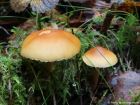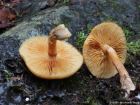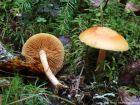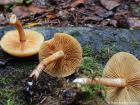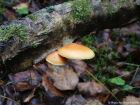Cap ochraceous with an apricot hue, lighter at the margin and gradually developing a more cinnamon tone as it ages. It has a silky-smooth texture and starts out convex, eventually expanding and becoming wavy. The flesh is the same colour as the cap, firm, and relatively thin. Gills initially straw-coloured or ochraceous, gradually turning more cinnamon at maturity, with orange-brown spots appearing. They are adnate with a slight tooth or sometimes slightly emarginate, and are densely crowded. Stem similar in colour to the cap, slender, and more or less uniform in thickness. It features a silky striate or fibrillose texture. A ring is either absent or appears as a faint zone when young. The flesh is yellowish, turning orange-brown when damaged, especially near the base, and is firm with a stuffed interior. Spore print rusty orange-brown.
Microscopic Features: The spores are ellipsoidal, measuring 7-9 x 4-5.5 µm, and are covered in very fine warts.
Gymnopilus penetrans on the First Nature Web site.
Gymnopilus penetrans on the California Fungi Web site.
Many mushrooms are poisonous, and some can be lethally toxic. Distinguishing between edible and poisonous mushrooms can be very challenging. Therefore, we strongly advise against consuming wild mushrooms. This website does not contain any information about the edibility or toxicity of mushrooms.
Although efforts have been made to ensure accuracy on this website, the information may contain errors and omissions. Therefore, all content provided is for educational and informational purposes only and should not be relied upon or used as a basis for consuming any plants or mushrooms.
External links are provided for reference only. We do not endorse or take responsibility for the content, advice, or products found on these sites or in any advertisements shown on this website.
